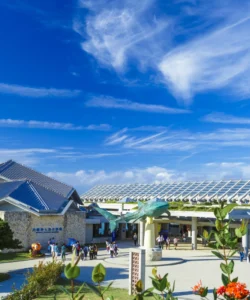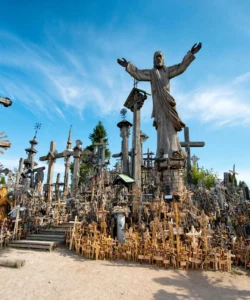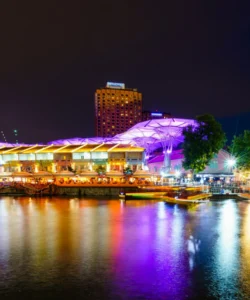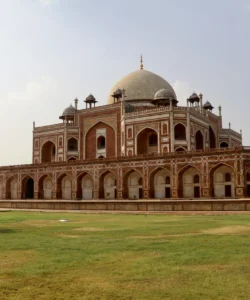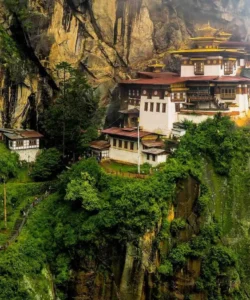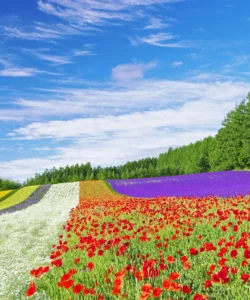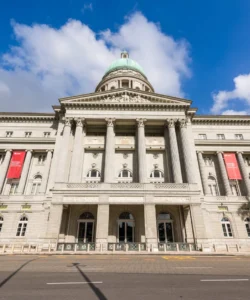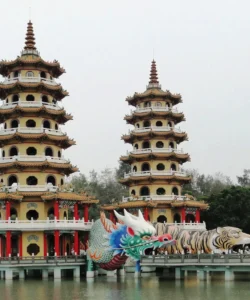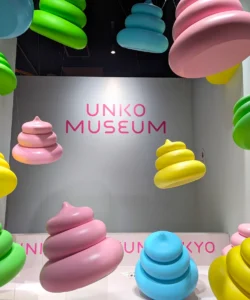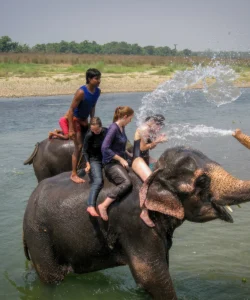Somapura Mahavihara, also known as Paharpur Buddhist Vihara, is a monumental archaeological site located in Paharpur, Naogaon District, Bangladesh. This ancient Buddhist monastery (mahavihara) was once one of the largest and most influential intellectual centers in the Indian Subcontinent, serving as a hub for Buddhist, Hindu, and Jain traditions. It stands as a profound testament to the architectural and cultural prowess of the Pala dynasty.
Name: Somapura Mahavihara (Bengali: সোমপুর মহাবিহার, Sōmpur Môhābihār; also Paharpur Buddhist Vihara, পাহাড়পুর বৌদ্ধবিহার)
Address: Paharpur, Badalgachhi, Naogaon District, Rajshahi Division, Bangladesh. It is located in northwestern Bangladesh.
How to Get There:
Access to Somapura Mahavihara typically involves reaching a major city in Bangladesh (like Dhaka or Rajshahi) and then taking land transport.
- By Air: The closest major airport is Shah Makhdum Airport (RJH) in Rajshahi, which has domestic flights from Dhaka. From Rajshahi, you would need to travel by road to Paharpur.
- Alternatively, fly into Hazrat Shahjalal International Airport (DAC) in Dhaka, and then continue by road or train.
- By Train: You can take a train from Dhaka’s Kamalapur Railway Station to Akkelpur Railway Station (around 5.5 hours). From Akkelpur, you can take a local auto-rickshaw or van-rickshaw to Somapura Mahavihara (approx. 20-30 minutes).
- By Bus: Buses from Dhaka (e.g., Gabtoli Bus Terminal) or Rajshahi are available to Naogaon or directly to Paharpur Bazar. From Paharpur Bazar, local transport (CNG, auto-rickshaw, van-rickshaw) is available for the final 2 km to the site. The drive from Dhaka can be long (7-8 hours).
- By Road (from Rajshahi): From the center of Rajshahi, it’s a 2 to 3-hour drive via the Rajshahi – Naogaon Hwy/R685 roads.
- Within the Site: The site is extensive (11 hectares / 27 acres) and best explored on foot. There is a small on-site museum.
- Entrance Fee: There is an entry fee for the site, with different rates for international and national tourists. The entry to the museum is usually included in the site ticket.
- Best Time to Visit: The cooler, dry season, from October to March, is ideal for visiting, as Bangladeshi summers can be hot and humid, and the monsoon (June-September) brings heavy rains.
Landscape and Architecture:
Somapura Mahavihara’s “architecture” is a remarkable example of Buddhist monastic design in the Pala period, characterized by its quadrangular layout and a massive central temple.
- Quadrangular Monastic Complex: The entire complex is laid out in a quadrangular (square) shape, with each side measuring approximately 922 feet (281 meters) long. It covers an area of around 11 hectares (27 acres), making it one of the largest monasteries of its kind south of the Himalaya.
- 177 Monastic Cells: The outer walls of the monastery are formed by 177 monastic cells that face inwards towards the central courtyard. These rooms were used by monks for accommodation, meditation, and study.
- Massive Central Shrine/Stupa: The most prominent feature of the complex is the massive central shrine (often interpreted as a stupa-shrine or a terraced temple with a stupa superstructure) located at the very heart of the inner courtyard. This central structure has a cruciform ground plan (shaped like a cross) and a terraced superstructure that rises in three tiers to a height of about 70 feet (21 meters). Its unique design is believed to have been influenced by earlier Hindu-Buddhist temples in India and in turn influenced Buddhist architecture as far away as Myanmar (Bagan) and Java (Borobudur).
- Terracotta Plaques: The outside walls of the central shrine and the lower parts of the quadrangular monastery walls are adorned with thousands of ornamental terracotta plaques. These plaques depict a wide variety of subjects, including Buddhist, Hindu, and Jain deities, mythological scenes, human figures engaged in daily activities (musicians, dancers, warriors), animals, and floral motifs. They offer valuable insights into the religious syncretism and daily life of the period.
- Sacred Geometry and Mandala Inspiration: The masterplan of Somapura Mahavihara is deeply inspired by Buddhist mandalas, representing spiritual harmony and the cosmos. Its precise geometric and symbolic model integrates various pathways, access points, and sacred spaces, all connected to the central monastery in a way that mimics a mandala’s radial symmetry, suggesting the builders were also cosmologists.
- Courtyards and Ancillary Buildings: Within the vast inner courtyard, numerous smaller stupas, shrines, and other ancillary buildings (e.g., dining halls, assembly halls, bathing tanks) have been discovered, reflecting the diverse functions of a large monastic university.
- Drainage System: The site had an intricate drainage system, though issues with poor drainage and high levels of salinity in the soil are ongoing conservation challenges.
- Materials: Primarily built of brick, reflecting the local construction practices of the Pala period. Stone sculptures are also present, often depicting a mixture of Buddhist, Hindu, and Jain motifs.
What Makes It Famous:
- UNESCO World Heritage Site: Designated a UNESCO World Heritage Site in 1985, Somapura Mahavihara is recognized for its unique artistic achievement and its influence on Buddhist architecture across the region.
- One of the “Five Great Mahaviharas”: It was one of the five “Great Monasteries” (Mahaviharas) of the Pala period in ancient Bengal and Magadha, which were renowned centers of Buddhist learning and pilgrimage (along with Nalanda, Vikramashila, Odantapura, and Jaggadala). Somapura was the largest in acreage.
- Influential Buddhist Architecture: Its unique cruciform ground plan and terraced structure are believed to have significantly influenced the development of Buddhist architecture in Southeast Asia, particularly the temple-mountains of Bagan (Myanmar) and Borobudur (Java, Indonesia), making it a crucial link in the spread of Buddhist art and ideas.
- Religious Syncretism: Despite being a Buddhist monastery, archaeological finds (including terracotta plaques and stone sculptures) demonstrate the presence and influence of Hindu and Jain traditions within the complex, highlighting a period of religious tolerance and cultural synthesis.
- Ancient Intellectual Center: It flourished as an important intellectual and monastic center from the 8th to the 12th centuries CE, attracting scholars and monks from across Asia (including the famous Atish Dipankar Srijnan, who translated texts here before going to Tibet), making it a hub of knowledge dissemination.
- Massive Scale: Its sheer size, covering 11 hectares (27 acres) with 177 cells, numerous stupas, and a colossal central shrine, makes it one of the grandest ancient monastic complexes ever excavated.
- Terracotta Art: The thousands of ornamental terracotta plaques adorning its walls are a significant artistic collection, providing a visual encyclopedia of the period’s religious beliefs and daily life.
Differences from Some Other Wonders:
- Cruciform Ground Plan for a Buddhist Monastery: While Borobudur is also a multi-terraced Buddhist monument, Somapura’s unique cruciform (cross-shaped) ground plan for its central shrine within a quadrangular monastery is a distinct architectural innovation for a Mahavihara, and a key element of its influence on Southeast Asian temple-mountains.
- Primary Influence on Southeast Asian Buddhist Architecture: Its specific role in influencing the design of later monumental Buddhist temples in Myanmar (Bagan) and Java (Borobudur) is a particularly famous aspect, making it a crucial source site for understanding regional architectural development.
- Massive Monastic Cells (177): The sheer number of monastic cells within its quadrangular enclosure, indicating its function as a large residential university, sets it apart from more exclusively temple-focused sites.
- Terracotta Plaque Dominance: While other sites have carvings or reliefs, Somapura’s extensive use of ornamental terracotta plaques as its primary decorative medium, depicting a blend of religious figures and secular life, is a defining artistic characteristic, different from the stone reliefs of Borobudur or sandstone carvings of Khajuraho.
- Archaeological Rediscovery in Modern Era: Like Ajanta Caves, it was “rediscovered” in the 19th century after centuries of abandonment, adding a layer of mystery and revealing a “lost” intellectual center.
- Located in Bangladesh: As one of the most significant ancient Buddhist sites in Bangladesh, it holds a unique national heritage status distinct from other ancient Buddhist sites in India or elsewhere in Southeast Asia.
- Multifaith Presence (Pala Era): While later sites might show religious syncretism, the direct archaeological evidence of Buddhist, Hindu, and Jain motifs existing side-by-side in a Buddhist monastery built under the patronage of a Buddhist dynasty (Pala) in the 8th-12th century is a strong testament to the unique religious tolerance of that period.
Somapura Mahavihara Photos:































